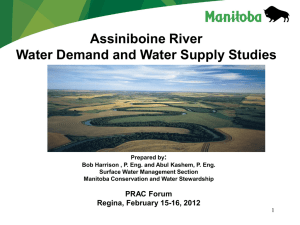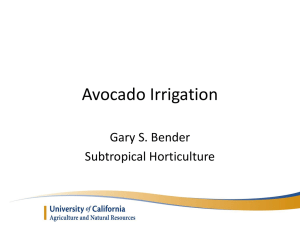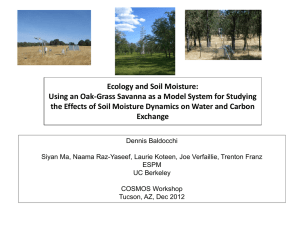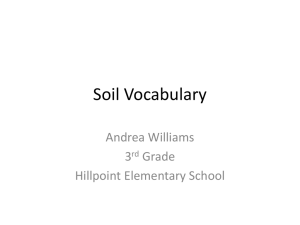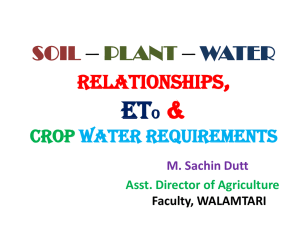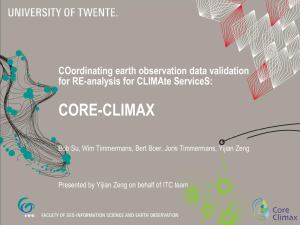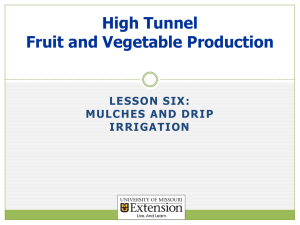Darrington Seward, Producer, Automated Irrigation
advertisement
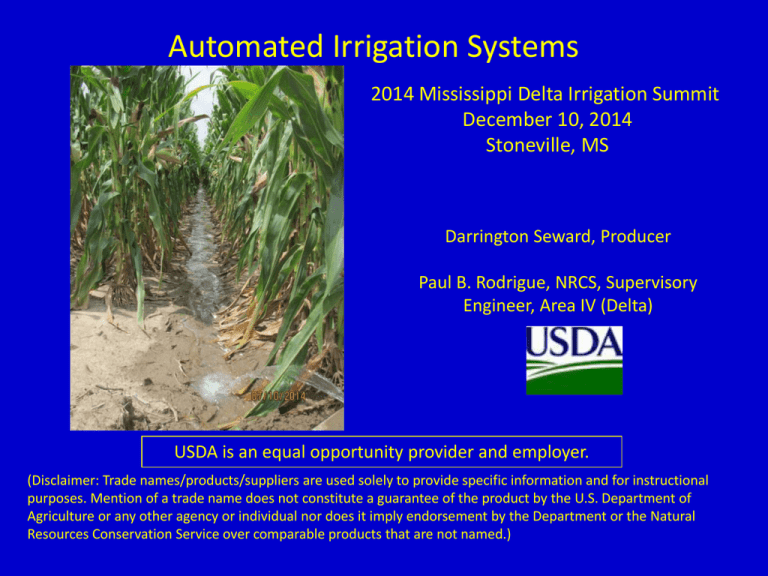
Automated Irrigation Systems 2014 Mississippi Delta Irrigation Summit December 10, 2014 Stoneville, MS Darrington Seward, Producer Paul B. Rodrigue, NRCS, Supervisory Engineer, Area IV (Delta) USDA is an equal opportunity provider and employer. (Disclaimer: Trade names/products/suppliers are used solely to provide specific information and for instructional purposes. Mention of a trade name does not constitute a guarantee of the product by the U.S. Department of Agriculture or any other agency or individual nor does it imply endorsement by the Department or the Natural Resources Conservation Service over comparable products that are not named.) NRCS F/A for Irrigation Automation - 2/5 irrigation History - verified by 2014 permit coverage for FY15 (you can check your coverage at this meeting with YMD) Automated Irrigation Systems Pump/Equipment - timers - float switches - surge valves - remote monitoring - remote control - center pivot Irrigation Decision - soil moisture sensors - weather data - scheduling program Automated Irrigation Systems - Utilize weather station data and/or moisture sensor data to determine when and for how long to water crops. Sensors are placed into the ground to monitor soil moisture and connected to a control system. - The control system can use real-time data from the sensor or a combination of inputs to determine irrigation time and amount. The sensor tells the computer how much moisture there is in the soil, which determines if water is required. - Automated systems typically save on labor, yet tend to be associated with higher equipment costs. - Though automated irrigation systems with moisture sensors and weather stations are being more widely adopted, their cost-effectiveness largely depends on the crop in question and broader market forces. Automated Irrigation Systems On-Farm Weather Stations: Rainfall, temperature, humidity, soil moisture, etc. - irrigation scheduling program Center Pivot – automation designed in (F/A) - key is adequate water (0.30 in/day capability) - soil infiltration capability must be adequate (soil health) Furrow - pump automation (timer) (F/A) - pump monitoring & control (F/A) - surge valves (automated cut-back scheme) (soil health) (F/A) - soil moisture sensors w/telemetry (F/A) Flood - pump automation (F/A) - pump monitoring & control (F/A) - water level sensors (F/A) Aquaculture - pump automation (F/A) - pump monitoring & control (F/A) - water level sensors (automated 6/3 method) (F/A) - split pond (F/A) Tailwater Recovery/On-farm storage - pump automation (F/A) - pump monitoring & control (F/A) - water level sensors (F/A) 533 – Pump Automation BASIC - The power unit can be stopped based upon a timer, water level sensor, or other IWM type device (typically does not apply to Center Pivots). INTERMEDIATE - Remote Start or Stop is required for ALL Intermediate Pump Automation. This system requires telemetry. _____ Diesel Engine Control/Monitoring ( 533 Intermediate required) - The power unit can be stopped or started remotely. - The RPM can be monitored remotely. - Engine shutdown times can be set to occur automatically. - Alert criteria can be set that provides specific conditions in which to shut down the engine and/or notify the operator of problems on their cell phone or other identified electronic device (e.g. tablet). - Monitoring of other power unit parameters - dashboard (rpm, energy consumption, oil pressure, etc.). 2 or more unit parameters must be monitored. (Electric requirements similar) 533 – Pump Automation ADVANCED - Remote Start and Stop is required for ALL Advanced Pump Automation. This system requires telemetry. _____ Diesel Engine Control/Monitoring ( 533 Advanced required) - The power unit can be stopped and started remotely. - The RPM can be monitored and changed remotely. - Engine shutdown times can be set to occur automatically. - Alert criteria can be set that provides specific conditions in which to shut down the engine and/or notify the operator of problems on their cell phone or other identified electronic device (e.g. tablet). - Monitoring of other power unit parameters - dashboard (rpm, energy consumption, oil pressure, center pivot location, etc.). 3 or more unit parameters must be monitored. Electric requirements similar. 533 – Pump Automation Electric Motors Variable Frequency Drive/Soft Start: - The control system shall be designed utilizing proven technology in control design for constant pressure, constant flow rate, or a combination of flow and pressure ranges to provide the desired operating conditions of the pumping system. This technology has several different names: Variable-Speed Drive (VSD) Adjustable-Speed Drive (ASD) Adjustable-Frequency Drive (AFD) Frequency Converter Inverter (a term used by manufacturers) Relatively new: discuss with your local electric supplier first. 442 – Sprinkler - systems to monitor flow, pressure, position, operation, system security ( Intermediate or Advanced Pump Automation) - use in conjunction with soil moisture sensors 443 – Surge Valves - Surge valve and controller: automated cut-back scheme - to decrease tailwater requirement, increase opportunity time for infiltration (3 siphon tubes, then 2 tubes, then 1 tube) Systems are pre-programmed with some operator adjustability. Picture credit: growingmagazine.com - use in conjunction with soil moisture sensors 587 – Flowmeters - fixed or portable flowmeter - manual read - recording - telemetry (typically used as part of 533- Advanced Pump Automation) Example of soil moisture sensor with telemetry. Long term record. Example of long term water level record on reservoir. Example of Tailwater Pit monitoring and Automatic/Remote Operation Consider Fall-Winter Soil Moisture Monitoring to see how the soil profile replenishes. Don’t wait till irrigation season starts to think about your soil moisture profile. GOSSYM/COMAX Ahead of its time is a mechanistic cotton growth model and expert system that simulates cotton growth given selected weather, soil, and management practices. Management options include fertilizer and irrigation strategies. GOSSYM operates on daily time steps and calculates material balances for water and nitrogen using weather and soil data to predict crop growth and crop yield. The model also calculates material balances and soil nitrogen uptake. Key Input: Soil moisture and bulk density for each soil horizon, and weather data (temperature, wind speed, solar radiation, and humidity). Then: Back then emphasis was on yield prediction. Now: emphasis on plant water stress, soil moisture levels, irrigation scheduling Today’s technology/automation, makes similar efforts more feasible today. QUESTIONS Thank you for your diligent, hard work and efforts on behalf of the Delta’s Resource Concerns! Natural Resources Conservation Service
